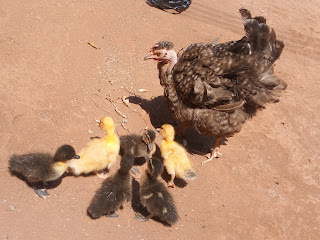Do you know what we normally call ‘local ducks’ here in Malawi are closely related, if not the same as the highly-priced Muscovy ducks? I have studied most of their traits and find them to be similar. So to describe the local duck and its benefits, I will use the Muscovy.
Muscovy duck (Cairina moschata) is a large duck native to Mexico, Central, and South America and Africa according to an entry on World's Poultry Science Journal.
They are some of the largest ducks on planet Earth. The males can grow up to 76 cm long and weigh up to 7 kilos. Females are usually smaller, growing up to 3.5 kg.
The bird is predominantly black and white, with the back feathers being iridescent and glossy in males, while the females are drabber. Both sexes have pink or red wattles around the bill, those of the male being larger and more brightly colored.
The one I recently slaughtered weighed 3 kg dressed weight!
Under scavenging, backyard farming conditions, the ducks can lay between 60 and 80 eggs each per year, and about 100 and 125 eggs per bird per year with an egg weight of about 72g under improved management conditions.
Fact
Partly due to the larger yolk, duck eggs are significantly higher in both fat and cholesterol than chicken eggs. But they're also higher in protein and have a higher concentration of omega-3 fatty acids, making them a favorite of paleo dieters, who seek high-fat foods. - https://modernfarmer.com.
Duck meat has a much stronger flavor than both chicken and turkey. The nearest comparison would be the darker parts of other poultry, but duck is still more flavorful, says nutritionadvance.com. As is the case with many foods, the higher fat content positively contributes to the overall taste profile.
Do you like baking? Try duck eggs, instead of chicken egg and you’ll love them forever.
Pricing
Despite these attributes, most farmers in Malawi, especially in rural areas, sell their ducks at low prices, ranging from K2000 (US 2.6) to K3500 (US 4.7). In urban set ups, the prices go up to K5000 (US 6.6) and K7000 (US 9.3) for fully-grown meat fowls. This is very low compared to the K10, 000 and K20, 000 for foreign breeds such as Pekin and Khaki.
Now, with all these benefits, why should local ducks fetch low prices? It is high time we appreciated what a delicacy and money spinner the ‘native Muscovy’ is.
 The measures were spelt out at the inaugural Malawi Banana Growers Conference in Lilongwe on Friday.
The measures were spelt out at the inaugural Malawi Banana Growers Conference in Lilongwe on Friday.





